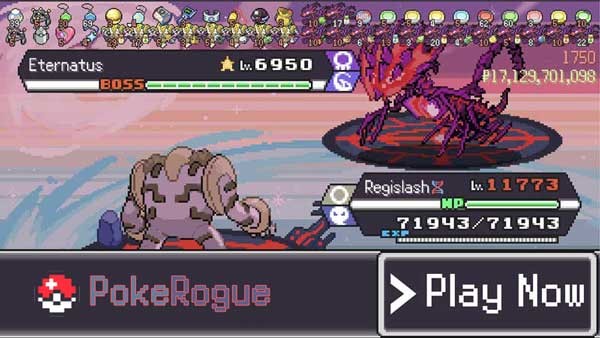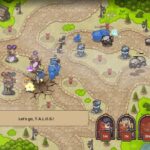PokeRogue has emerged as a thrilling fusion of the beloved Pokemon universe and the challenging roguelite genre. If you’re a Pokemon enthusiast seeking a fresh strategic experience, PokeRogue’s procedurally generated worlds offer endless replayability. Each playthrough presents a unique map, demanding adaptability and smart resource management. While not featuring permadeath in the strictest sense, PokeRogue provides a compelling challenge where understanding map elements is key to victory. This guide will delve into the intricacies of PokeRogue maps, helping you navigate biomes, conquer stages, and ultimately master this captivating game.
What is PokeRogue? A Roguelite Pokemon Adventure
For those new to the adventure, PokeRogue is a browser-based game that reimagines Pokemon gameplay through a roguelite lens. Unlike traditional Pokemon games with fixed routes and predictable encounters, PokeRogue throws you into procedurally generated maps. This means every run is different; the layout of the world, the Pokemon you encounter, and the challenges you face are constantly changing. This dynamic environment is what makes a “Pokerogue Map Guide” so essential for players looking to enhance their strategic approach and succeed in this ever-shifting landscape.
 pokerogue-banner2
pokerogue-banner2
Image alt text: PokeRogue game banner showcasing diverse Pokemon in a dynamic battle scene, emphasizing the roguelite experience.
Understanding PokeRogue Maps: Procedural Generation and Biomes
The core of PokeRogue’s unique gameplay lies in its procedurally generated maps. Forget memorizing routes; each new game generates a fresh world for you to explore. These maps are structured into stages and biomes, each presenting distinct environments and challenges.
How Procedural Maps Work in PokeRogue
Procedural generation ensures that no two PokeRogue playthroughs are ever quite the same. The game algorithmically creates maps, determining the layout of paths, the placement of encounters (wild Pokemon, trainers, bosses), and the overall structure of each biome. This dynamic map generation is what necessitates a flexible strategy rather than rote memorization. Understanding how biomes and stages are organized within these maps is crucial for effective navigation and planning your PokeRogue journey.
Exploring Different Biomes: A Map Guide
PokeRogue’s world is divided into biomes, thematic zones that dictate the types of Pokemon you’ll encounter and the overall aesthetic of the map. Each biome typically spans ten stages, culminating in a boss battle. The initial biomes are generally more forgiving, introducing you to common Pokemon types. As you progress deeper into the game, you’ll encounter increasingly challenging biomes with rarer and more powerful Pokemon.
Here’s a breakdown of what you can expect from PokeRogue biomes:
- Starting Biomes (Town, Plains): These early areas are populated with familiar Normal, Grass, and Bug-type Pokemon. They serve as an introductory phase to build your team and understand the game mechanics.
- Later Biomes (Cave, Forest, Water, etc.): As you advance, you’ll venture into biomes like caves, forests, and water areas. These biomes feature Pokemon types associated with their environment – Rock and Ground types in caves, Grass and Bug types in forests, and Water types in aquatic biomes.
- Biome Bosses: Every tenth stage marks the end of a biome and features a boss encounter. This could be a Gym Leader thematically linked to the biome or a powerful Boss Pokemon. Defeating these bosses is a significant milestone, rewarding you with party healing, EXP-boosting charms, and sometimes Egg Tickets.
Understanding the biome you’re currently in is vital for strategizing your team composition and anticipating the types of Pokemon and challenges you’ll face. While there isn’t a static “PokeRogue map” to download, recognizing biome patterns becomes your internal map guide.
Navigating the PokeRogue Map: Key Elements and Strategies
While PokeRogue maps are procedurally generated, there are consistent elements and strategic approaches you can employ for effective navigation.
Understanding Map Icons and Symbols
PokeRogue’s map interface uses icons to represent different locations and encounters. While the game is browser-based and may evolve, common icons in roguelite games (and likely applicable to PokeRogue) often include:
- Wild Pokemon Encounters: Icons indicating areas where you’ll battle wild Pokemon.
- Trainer Battles: Icons signifying encounters with trainer opponents.
- Boss Battle Markers: Distinct icons for stages ending in a boss fight.
- Healing Locations: Potentially icons representing areas where you can heal your Pokemon (though healing is often tied to biome/boss completion in PokeRogue).
- Item Locations (if implemented): In future updates, there might be icons for areas where you can find items.
Paying attention to these icons, once fully clarified within PokeRogue’s interface, will be crucial for planning your route and deciding which encounters to prioritize or avoid.
Strategic Map Navigation Tips
Since you can’t rely on a fixed map layout, strategic navigation in PokeRogue is about making informed decisions based on the current procedural generation and your team’s strengths:
- Biome Awareness: As mentioned, always be aware of the current biome to anticipate Pokemon types and plan your team accordingly.
- Resource Management: In roguelites, resource management is key. Conserve your healing items and Pokeballs. Engage in battles strategically, not recklessly.
- Adaptability: Be prepared to adapt your team and strategy based on the Pokemon you encounter and the biome challenges. Procedural generation rewards flexibility.
- Prioritize Team Building: Focus on building a well-rounded team that can handle a variety of Pokemon types. This is more important than aiming for specific Pokemon, as encounter availability is random.
Mastering PokeRogue Stages and Challenges
Each biome in PokeRogue is composed of ten stages. These stages are the stepping stones of your adventure, each presenting unique challenges and contributing to your overall progression.
Stages, Trainers, and Boss Battles on the Map
- Wild Pokemon Stages: Most stages will involve encounters with wild Pokemon. These battles are essential for gaining EXP, leveling up your team, and potentially catching new Pokemon. Remember that stat changes from wild battles persist, requiring strategic play.
- Trainer Stages: Trainer battles can appear unexpectedly within stages. These are more challenging than wild encounters as trainers use strategic switching and super-effective moves. Unlike wild battles, stat changes reset before trainer fights, demanding a different tactical approach.
- Boss Stages: Stages 10, 20, 30, and so on, are Boss Stages. These culminate in battles against Gym Leaders or powerful Boss Pokemon thematically tied to the biome. Defeating biome bosses is crucial for progression and rewards.
Navigating these stages effectively involves balancing resource expenditure, team development, and strategic battle choices. Understanding the stage structure within biomes is a key aspect of mastering the “PokeRogue map” concept.
Essential Controls for Map Exploration
Navigating the PokeRogue map is straightforward, utilizing intuitive controls, especially for Pokemon game veterans.
- Arrow Keys: Used for moving your character around the map.
- Z / ENTER / SPACE: Action button for selecting options, interacting with the environment, and advancing dialogue.
- X / BACKSPACE: Cancel button for rejecting options or moving back in menus.
- M / ESC: Access the game menu.
- +/-: Adjust game speed.
These simple controls allow you to easily explore the procedurally generated maps and engage with the game’s various elements.
Items and their Impact on Map Exploration
Items play a vital role in PokeRogue, both in battles and potentially in map exploration (depending on future updates). While the initial description focuses on battle items, understanding item utility is crucial for a successful PokeRogue run.
- Pokeballs: Essential for expanding your team by capturing wild Pokemon.
- Healing Items (Potions, Revives): Crucial for sustaining your team’s health throughout your map exploration and stage progression.
- Stat-Boosting Items: Can provide temporary advantages in battles encountered on the map.
- Evolution Stones: Used to evolve specific Pokemon, potentially impacting your team composition and strategy for map challenges.
- Held Items: Offer passive benefits to your Pokemon, enhancing their capabilities for map encounters and battles.
Managing and utilizing these items effectively is another layer of strategic depth in PokeRogue, impacting your ability to explore further and overcome map challenges.
Conquer PokeRogue’s Dynamic Maps
While a traditional “PokeRogue map guide” in the form of a static image isn’t applicable due to procedural generation, understanding the principles of biome structure, stage progression, strategic navigation, and resource management becomes your ultimate guide. By grasping these concepts and adapting to each unique playthrough, you’ll be well-equipped to conquer the ever-changing worlds of PokeRogue and become a true master of this roguelite Pokemon adventure. Dive into PokeRogue today and test your map-reading skills in this exciting and unpredictable game!
